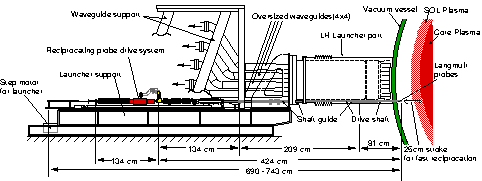Objectives
A fast reciprocating Langmuir (electrostatic) probe system (RPS) has been incorporated into a multi-junction launcher system for Lower Hybrid (LH) wave injection (Photo from VV).
Scrape-off layer (SOL) plasma data, i.e. profiles of electron temperature, ion saturation current and floating potential, have been measured in order to investigate the transport mechanism in the boundary region.
In 1998, probe head design was modified from triple probe type (one double probe and one floating probe) to Mach probe type (two double probes and one floating probe) to measure SOL plasma flow along the field lines. The SOL plasma flow and diffusion mechanisms have been studied in the W-shaped divertor.
Specification
| Langmuir probes : | Two double probes for Te, Is measurement at up-stream and down-stream sides of the field lines (i.e. Mach probe), and a floating probe for potential measurement. Head and 5 electrodes are made of carbon fiber composite (CFC). |
| Spatial resolution : | 1-2 mm in radial direction. It has provided high spatially resolved profiles of the local electron temperature (Te) and ion saturation current (Is) in the SOL. |
| Scanning speed : | 25cm for ~0.5s (~50 cm/s) |
| Driving component : | a compact pneumatic cylinder and steel springs. Total mass of the moving components is about 25kg. |
| Position : | P-18 section, midplane LH launcher port |
| (2005) Probe head and electrodes were replaced. | |

References
[1] N. Asakura et al., Review of Scientific Instruments, Vol.66 (1995) pp. 5428-5432.
[2] N. Asakura et al., Journal of Nuclear Materials, Vol.241-243 (1997) pp. 559-563.
[3] Y. Ikeda et al., Nucl. Fusion Supplement (proc. 15th Int.Conf. Plasma Physics & Controlled Research, Sevilla, 1994), Vol.I (IAEA, Vienna, 1995) p415.
[4] N. Asakura et al., Nuclear Fusion, Vol.39 (1999) pp. 1983-1991.
[5] N. Asakura et al., Physical Review Letters, Vol.84 (2000) pp. 3093-3096.
[6] N. Asakura et al., Plasma Phys. Control. Fusion, Vol.44 (2002) A313.

